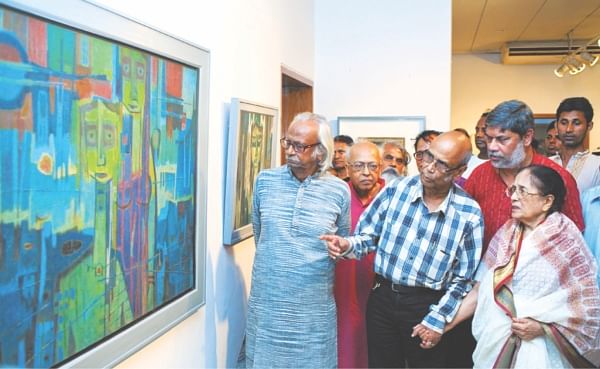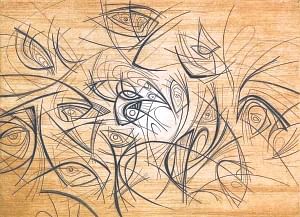| Home - Back Issues - The Team - Contact Us |
 |
| Volume 11 |Issue 24| June 15, 2012 | |
|
|
Art
An Artist of the Floating World Safiuddin Ahmed, who recently passed away, was a maestro of printmaking Fayza Haq Shilpo Guru Safiuddin Ahmed, who left us recently and passed away to the celestial clouds, stood tall, with a tapering waistline and handle-bar moustache. He looked like some Italian actor or prince of some kingdom. His prints are mostly in earthy colours, yellow and red—along with stark black and white– brought waves, oval shapes, circular dots and lines. Bengal Gallery of Fine Arts in Dhanmondi has been holding a grand retrospective of the late maestro from June 5, ending June 16.
The Liberation War and the heartless and mindless Pakistan army and what had gone before in 1952– with open protests and shooting– was unbearable to the sensitive, tranquillity seeking soul of Safiuddin Ahmed and his co-mates like Mohammed Kibria. Apart from delineating men in tranquil boats, Safiuddin's impeccable prints in black and white depicted them going to the market, riding a donkey, followed by dogs and covered by umbrellas. The printmaker brought in the sky and the gathering clouds. The trees in the backdrop and the collected water ways in front were in perfect harmony. There were the farmers, riding and carrying on their work. Vermilion, orange, shades of brown and black bounced on his prints, unique and unforgettable. Like SM Sultan, the farmers and fishermen were the ordinary sun–burnt people Safiuddin saw. He presented their back-breaking and toiling muscles in the sun in his inimitable paints, which reached the length and breath of Subcontinent including the then Pakistan. Safiuddin's work was like Zainul Abedin's, whose prints on the Bengal Famine of the early forties, with potbellied scavengers and the earthy coloured painting of the splendid, striding “Santal” couple will remain indelible prints on our mind. Safiuddin Ahmed's strokes and lines will always be remembered. Fishing boats and fishing nets recur in his etchings. He used geometrical, semi abstract, traditional shapes in his prints, depicting Nature and people like heart throbs, showing people's anger at the surrounding and the brewing political turmoil in the erstwhile East Pakistan. His paintings were a prelude to his prints. His woodcuts and engravings showed mastery over dramatic light and shade.
Bamboo and neem leaves framed the cemented podium of the lawn of Bengal Gallery. Here senior artists and intellectuals such as Rafiqun Nabi, Dr Burhanuddin K Jahangir and Qayyum Chowdhury spoke form their heart. The blood red rose blossoms and egret white spray of tube roses formed the spray that decorated the table with speakers to ease themselves of the cushion covered rattan chairs. Plastic chairs waited for the listeners. The backdrop was formed by the late artist's portrait and a huge print with boats and sails in blue and watermelon A single palm tree, pink with its trunk notched, grew at the back. The cemented jungle could be seen with the accompanying air-conditioners on window sills. The big boulders of the rockery held back the leaves of the tall bamboo shrub.
Subir Chowdhury spoke of a folio on the artist, which took Shilpakala Academy five years in the making, being stalled by the great icon in print-making himself. Subir mentioned his first exhibition in Bangladesh, way back in 2008. He also spoke of the help from Italian art experts. He was glad that the great master of lines and forms was put to rest with his co-mates– Zainul Abedin and Qamrul Hassan– within the Dhaka Art College premises. Abul Mansur, spoke of how it was being a close student of the great artist. He spoke of how he had brought art to a formal existence in the 1950s. Rafiqun Nabi, his bronzed face framed with his flying white hair, spoke of the times he was in Narinda and shopped in the vicinity, and played with prices and quality of the content matter. The two, student and teacher, were of the same neighbourhood. Nabi saw the students interaction with the maestro, as most entertaing with his usual camaraderie and wit. Posessive of his works, so much so that he never sold a single one of them, Safiuddin’s immaculate artistic creations will be a reminder of that generation of artists who brought groundbreaking innovations to our art scene. The retrospective Tribute of Safiuddin Ahmed will end on June 16 at the Bengal Gallery of Fine Arts.
|
||||||||||||
|



